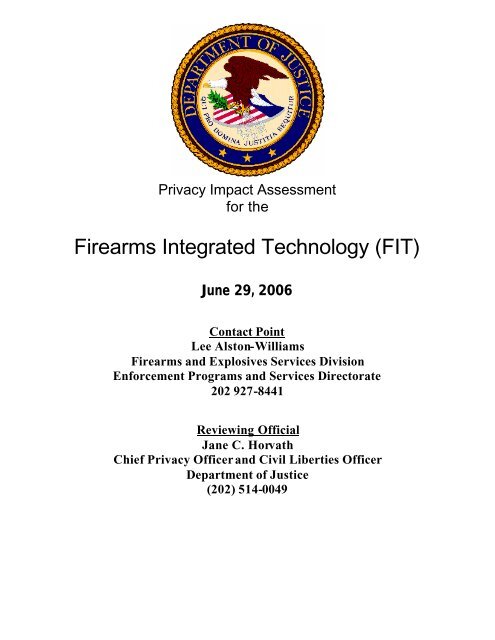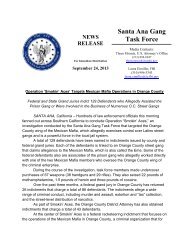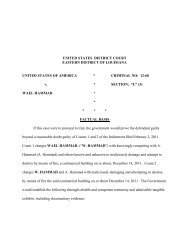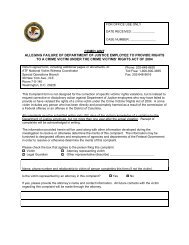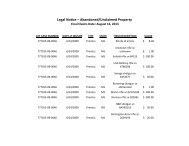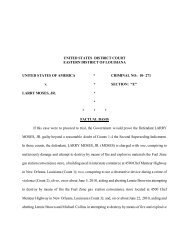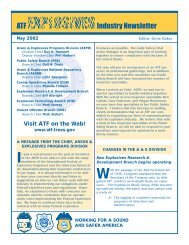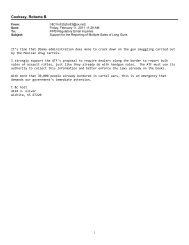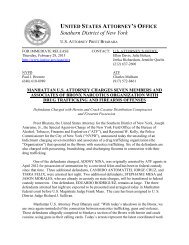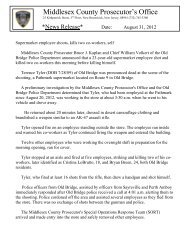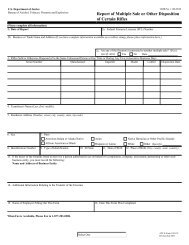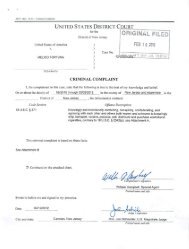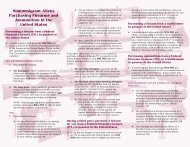Firearms Integrated Technology (FIT) - ATF
Firearms Integrated Technology (FIT) - ATF
Firearms Integrated Technology (FIT) - ATF
Create successful ePaper yourself
Turn your PDF publications into a flip-book with our unique Google optimized e-Paper software.
Privacy Impact Assessment<br />
for the<br />
<strong>Firearms</strong> <strong>Integrated</strong> <strong>Technology</strong> (<strong>FIT</strong>)<br />
June 29, 2006<br />
Contact Point<br />
Lee Alston-Williams<br />
<strong>Firearms</strong> and Explosives Services Division<br />
Enforcement Programs and Services Directorate<br />
202 927-8441<br />
Reviewing Official<br />
Jane C. Horvath<br />
Chief Privacy Officer and Civil Liberties Officer<br />
Department of Justice<br />
(202) 514-0049
Introduction<br />
Page 2<br />
The Bureau of Alcohol, Tobacco, <strong>Firearms</strong> and Explosives’ (<strong>ATF</strong>) mission is to provide industry<br />
regulation, revenue collection and protection, and law enforcement of federal statutes regarding firearms,<br />
explosives, arson, alcohol and tobacco. In support of the firearms component of its mission, Enforcement<br />
Programs and Services (EPS) Directorate has developed over 20 applications to perform crime gun<br />
tracing, firearms licensing, and firearms law enforcement. Unfortunately, EPS systems have been<br />
developed using a “stove pipe,” standalone implementation, resulting in data and application logic<br />
redundancy, making application maintenance and enhancements increasingly difficult. Additionally, <strong>ATF</strong><br />
is planning to meet the 1998 Government Paperwork Elimination Act (GPEA), which requires federal<br />
agencies to provide for the option of electronic submission of information as a substitute for paper.<br />
The <strong>Firearms</strong> <strong>Integrated</strong> <strong>Technology</strong> (<strong>FIT</strong>) investment closes an existing gap in the Bureau’s mission and<br />
ability to effectively provide focused, real- time, integrated information products for <strong>ATF</strong> agents and<br />
inspectors, our federal partners, industry, foreign allies, stakeholders and the general public.<br />
Through this initiative, <strong>ATF</strong> will modernize the current IT infrastructure creating opportunities for<br />
database consolidation as well the retirement of legacy systems. <strong>FIT</strong> will help to create a web-enabled,<br />
customizable, information analysis portal, whereby <strong>ATF</strong> personnel can acquire firearms, arson and<br />
explosives information to better protect the public, prevent diversion, deter violent crime, disrupt /<br />
prevent terrorist attacks, support Homeland Security initiatives, and protect our National Security.<br />
Additionally, this investment supports <strong>ATF</strong>’s core mission objective of enforcing the Federal firearms<br />
laws. e.g., the Gun Control Act (GCA) and the National <strong>Firearms</strong> Act (NFA). From a technology<br />
standpoint, <strong>FIT</strong> will integrate the various systems and applications <strong>ATF</strong> uses to fulfill its regulatory and<br />
enforcement mission. These systems are listed in the table below:<br />
System Name Acronym<br />
Annual <strong>Firearms</strong> Manufacture and Exportation Report AFMER<br />
Electronic Forms 6 eForm 6<br />
<strong>Firearms</strong> and Explosives Imports System FEIS<br />
Federal Licensing System( including FFLeZ Check and automated<br />
Criminal History Check (ACHC))<br />
FLS<br />
National <strong>Firearms</strong> Act NFA<br />
Currently, <strong>ATF</strong> personnel must access ten or more systems to view the complete history of a particular<br />
crime gun. The goal of <strong>FIT</strong> is to eliminate the standalone and isolated applications and ensure that all<br />
firearms and explosives systems interface and communicate effectively with other <strong>ATF</strong> systems.<br />
In 2003, the Safe Explosives Act (SEA), which amended Title XI of the Organized Crime Control Act of<br />
1970, (18 U.S.C. Chapter 40), was enacted. Modifications were made, and are currently being made to<br />
the FLS component of <strong>FIT</strong>, by the <strong>Firearms</strong> and Explosives Services Division, the owners of <strong>FIT</strong>-<br />
<strong>Firearms</strong> Services Applications (FSA) to support the SEA. The FLS is the automated system used to<br />
issue Federal firearms and explosives licenses and permits and for tracking license information on firearm<br />
and explosive manufacturers, importers, and dealers. The Federal <strong>Firearms</strong> Licensing Center (FFLC) and<br />
Federal Explosives Licensing Center (FELC) use the system to support the process of reviewing and<br />
making final determinations on applications for firearms and explosives licenses and permits. The new<br />
legislation enables <strong>ATF</strong> to systematically identify and conduct background checks on such employees, to
Page 3<br />
reduce the risk that prohibited persons will gain access to explosives. The SEA also expands the<br />
categories of prohibited persons to inc lude: (1) aliens (with limited exceptions); (2) persons dishonorably<br />
discharged from the military; and (3) citizens of the United States who have renounced their citizenship.<br />
Section 1.0<br />
The System and the Information Collected and Stored within<br />
the System.<br />
The following questions are intended to define the scope of the information in the system,<br />
specifically the nature of the information and the sources from which it is obtained.<br />
1.1 What information is to be collected?<br />
Information collected in <strong>FIT</strong> is required by <strong>ATF</strong> personnel to make determinations as to whether<br />
an application for a permit or license for firearms and explosives, or the possession or transfers of<br />
National <strong>Firearms</strong> Act Weapons or the importation of firearms, ammunitions or implement of<br />
war, is to be approved. The demographical information that is collected included the name, date<br />
of birth, social number, alien registration number, maiden name race, sex and place of birth.<br />
1.2 From whom is the information collected?<br />
The information is collected from the firearms or explosives license/permit applicants and<br />
employees of the explosives licensees or permittees, persons wishing to import firearms into to<br />
the US, and persons wishing to possess National <strong>Firearms</strong> Act (NFA) weapons.<br />
Section 2.0<br />
The Purpose of the System and the Information Collected<br />
and Stored within the System.<br />
The following questions are intended to delineate clearly the purpose for which information is<br />
collected in the system.<br />
2.1 Why is the information being collected?<br />
The information is collected to determine if the applicant, licensee or permittee, has suitable<br />
business premises and is not prohibited form conduction business in the regulated industry for<br />
which it intends to do business.
DISCLOSURE<br />
2.2 What specific legal authorities, arrangements, and/or<br />
agreements authorize the collection of information?<br />
Confidentiality of Tax Return Information, 26 U.S.C. § 6103 -<br />
Freedom of Information Act, 5 U.S.C. § 552 -<br />
Privacy Act, 5 U.S.C. § 552a –<br />
ETHICS<br />
Ethics in Government Act of 1978 -<br />
Hatch Act -<br />
EXPLOSIVES<br />
Title XI of the Organized Crime Control Act of 1970, 18 U.S.C. Chapter 40 -<br />
Title XI of the Organized Crime Control Act of 1970 (18 U.S.C. Chapter 40) establishes controls over<br />
explosive materials, including black powder and other pyrotechnic compositions commonly used in<br />
fireworks. Part 55 of Title 27, Code of Federal Regulations (CFR), contains the regulations which<br />
implement Title XI. § 555.141(a)(7) exempts "the importation and distribution of fireworks classified as<br />
Class C explosives and generally known as 'common fireworks,' and other Class C explosives, as<br />
described by U.S. Department of Transportation regulations in 49 CFR 173 .100(p),(r),(t),(u), and (x)."<br />
FIREARMS<br />
Gun Control Act, 18 U.S.C. Chapter 44 -<br />
Page 4<br />
(a) The Attorney General may prescribe only such rules and regulations as are necessary to carry out the<br />
provisions of this chapter, including—<br />
(1) regulations providing that a person licensed under this chapter, when dealing with another person so<br />
licensed, shall provide such other licensed person a certified copy of this license;<br />
(2) regulations providing for the issuance, at a reasonable cost, to a person licensed under this chapter, of<br />
certified copies of his license for use as provided under regulations issued under paragraph (1) of this<br />
subsection; and<br />
(3) regulations providing for effective receipt and secure storage of firearms relinquished by or seized<br />
from persons described in subsection (d)(8) or (g)(8) of section 922.<br />
No such rule or regulation prescribed after the date of the enactment of the <strong>Firearms</strong> Owners’ Protection<br />
Act may require that records required to be maintained under this chapter or any portion of the contents of<br />
such records, be recorded at or transferred to a facility owned, managed, or controlled by the United<br />
States or any State or any political subdivision thereof, nor that any system of registration of firearms,<br />
firearms owners, or firearms transactions or dispositions be established. Nothing in this section expands<br />
or restricts the Secretary’s [1] authority to inquire into the disposition of any firearm in the course of a<br />
criminal investigation.<br />
(b) The Attorney General shall give not less than ninety days public notice, and shall afford interested<br />
parties opportunity for hearing, before prescribing such rules and regulations.<br />
(c) The Attorney General shall not prescribe rules or regulations that require purchasers of black powder
Page 5<br />
under the exemption provided in section 845 (a)(5) of this title to complete affidavits or forms attesting to<br />
that exemption<br />
National <strong>Firearms</strong> Act, 26 U.S.C. Chapter 53 -<br />
The National <strong>Firearms</strong> Act provides for the registration, and the taxing of the transfer, of a class of<br />
weapons described as NFA Title 2 weapons (sometimes referred to as "Class 3 weapons"). These include<br />
machine guns, short barreled rifles, short barreled shotguns, silencers (also known as suppressors) and<br />
also a class of weapons known as "Any Other Weapon" (AOW). An example of an AOW is, but not<br />
limited to, a smooth barreled pistol or a short barreled combination gun.<br />
Brady Handgun Violence Prevention Act -<br />
Federal firearms licensee required to conduct criminal background check before transfer of firearm to<br />
non-licensee.<br />
FORFEITURE<br />
Forfeiture Laws, 18 U.S.C. §§ 981, 982 -<br />
Providing false information to U.S. Customs related to the importation of merchandise into the United<br />
States may be a criminal and, or, civil violation. Primary laws associated with violations found in Title 18<br />
U.S. Code and other statutes, including the following:<br />
18 USC 541 Entry of goods falsely classified<br />
18 USC 542 Entry of goods by false statements<br />
18 USC 545 Smuggling into U. S.<br />
18 USC 981-982 Forfeiture<br />
18 USC 1001 False statements, generally<br />
18 USC 1956-1957 Money laundering<br />
18 USC 2319-2320 Intellectual Property Rights<br />
15 USC 1121-1127 Trademarks<br />
17 USC Copyrights<br />
19 USC Customs laws<br />
35 USC Patents<br />
In addition, violations of Title 18 Sections 542 and 545 provide a basis to charge money laundering under<br />
Title 18 Sections 1956 and 1957. Funds used to promote the violations of Title 18 Sections 542 and 545<br />
or the proceeds of the violations may be forfeited to the U.S. government through Sections 981 and 982.<br />
The U.S. Customs Service shares forfeited assets with domestic and foreign law enforcement agencies<br />
who participated in the investigations.<br />
Gun Control Act, 18 U.S.C. § 924(d) -<br />
The primary focus of Title I of the Gun Control Act is to provide federal assistance to state firearms<br />
control efforts by requiring licensing for all persons dealing in firearms or ammunition. The Gun Control<br />
Act also specifies certain high risk individuals who are declared ineligible to purchase firearms. Other<br />
provisions in the Title prohibit interstate mail order sale of all firearms and ammunition, interstate sale of<br />
all handguns, interstate sale of certain long gun, and importation of non-sporting firearms.[14]<br />
National <strong>Firearms</strong> Act, 26 U.S.C. § 5872 -
Page 6<br />
The National <strong>Firearms</strong> Act provides for the registration, and the taxing of the transfer, of a class of<br />
weapons described as NFA Title 2 weapons (sometimes referred to as "Class 3 weapons"). These include<br />
machine guns, short barreled rifles, short barreled shotguns, silencers (also known as suppressors) and<br />
also a class of weapons known as "Any Other Weapon" (AOW). An example of an AOW is, but not<br />
limited to, a smooth barreled pistol or a short barreled combination gun.<br />
INTERNATIONAL LAW (AS APPLICABLE PURSUANT TO TREATY OR FEDERAL LAW)<br />
European Union Laws -<br />
Inter-American Convention Against the Illicit Manufacturing of and Tr afficking in <strong>Firearms</strong>, Ammunition,<br />
Explosives, and Other Related Materials -<br />
World Trade Organization -<br />
LITIGATION<br />
TAX<br />
Internal Revenue Code of 1986, Title 26, United States Code -<br />
2.3 Privacy Impact Analysis: Given the amount and type of<br />
information collected, as well as the purpose, discuss what<br />
privacy risks were identified and how they were mitigated.<br />
The data required is limited to what is authorized by Federal law and regulation in order to act<br />
appropriately on an application. Information is only disseminated on a need to know basis.<br />
Information relating to NFA is not disclosed to anyone except the applicants. Standard Operating<br />
Procedures (SOP’s), system user’s manuals, and employees’ desk manuals that are issued to all<br />
employees within the <strong>Firearms</strong> and Explosives Services Division (FESD). These manuals outline<br />
the employee’s responsibilities and to the acquisition, handling and protection of the data for each<br />
automated system.<br />
Section 3.0<br />
Uses of the System and the Information.<br />
The following questions are intended to clearly delineate the intended uses of the information in<br />
the system.<br />
3.1 Describe all uses of the information.<br />
The system is used to generate the required licenses, permits, transfer authorizations and approval<br />
required to engage in regulated activities involving the manufacture, import, dealing, use or<br />
transfer of firearms and/or explosives. The system is used to generate report relating to these<br />
activities.
Page 7<br />
3.2 Does the system analyze data to assist users in identifying<br />
previously unknown areas of note, concern, or pattern?<br />
(Sometimes referred to as data mining.)<br />
Yes. Each system has internal reports for which data can be mined for trend analysis and<br />
performance reporting.<br />
3.3 How will the information collected from individuals or<br />
derived from the system, including the system itself be<br />
checked for accuracy?<br />
All reports are reviewed and tested by member of an <strong>Integrated</strong> Project Team to determine their<br />
accuracy prior to being placed into production. There are also validations built within the<br />
systems that prevent the entry of inaccurate data.<br />
3.4 What is the retention period for the data in the system?<br />
Has the applicable retention schedule been approved by<br />
the National Archives and Records Administration<br />
(NARA)?<br />
<strong>FIT</strong> is a permanent system of records. The retention schedule is scheduled to be drafted in July<br />
2006.<br />
3.5 Privacy Impact Analysis: Describe any types of controls<br />
that may be in place to ensure that information is handled<br />
in accordance with the above described uses.<br />
Each system within <strong>FIT</strong> has User Guides, the FIS-FSA System Security Plan, <strong>FIT</strong>-FSA Risk<br />
Assessment and Contingency Plan that are strictly adhered to. Any release of information must<br />
be approved by a supervisor, including responses to FOIA requests.<br />
Section 4.0<br />
Internal Sharing and Disclosure of Information within the<br />
System.<br />
The following questions are intended to define the scope of sharing both within the Department<br />
of Justice and with other recipients.
4.1 With which internal components of the Department is the<br />
information shared?<br />
The FBI and other components on a case by case basis, to the extent authorized by Federal law.<br />
Page 8<br />
4.2 For each recipient component or office, what information is<br />
shared and for what purpose?<br />
<strong>FIT</strong> information is shared with the FBI for the purpose of conducting “criminal background<br />
checks” to determine if an applicant is a “prohibited person”.<br />
4.3 How is the information transmitted or disclosed?<br />
Fingerprint cards are either mailed to the FBI for processing or scanned and transmitted through<br />
an electronic batch file. Demographical data such as the name, date of birth, race, sex and social<br />
security number is encrypted and transmitted electronically.<br />
4.4 Privacy Impact Analysis: Given the internal sharing,<br />
discuss what privacy risks were identified and how they<br />
were mitigated.<br />
Firewalls, dedicated circuits and encryption is used to protect the data provided in the electronic<br />
files.<br />
Section 5.0<br />
External Sharing and Disclosure<br />
The following questions are intended to define the content, scope, and authority for information<br />
sharing external to DOJ which includes foreign, Federal, state and local government, and the<br />
private sector.<br />
5.1 With which external (non-DOJ) recipient(s) is the<br />
information shared?<br />
Federal, State and local governments often request information on the names and location of<br />
Federal firearms and explosives licensees and permittees, as well as other information, which is<br />
only provided as authorized by Federal law. Private sector can request the information through<br />
the Freedom of Information Act.
5.2 What information is shared and for what purpose?<br />
Page 9<br />
Names and locations of Federal firearms licensee and permittees, and other law enforcement and<br />
regulatory information, to ensure that they are aware and in compliance with other Federal, State<br />
and local laws and regulations.<br />
5.3 How is the information transmitted or disclosed?<br />
It is disclosed through the use of printout or electronic media such as CD’s for diskettes.<br />
5.4 Are there any agreements concerning the security and<br />
privacy of the data once it is shared?<br />
The information is to be used only for official purposes and tax information is subject to the<br />
disclosure restrictions in 26 U.S.C. 6103. All CD’s, printout, and disk are marked with “FOR<br />
OFFICIAL USE ONLY”.<br />
5.5 What type of training is required for users from agencies<br />
outside DOJ prior to receiving access to the information?<br />
Not aware of any.<br />
5.6 Are there any provisions in place for auditing the<br />
recipients’ use of the information?<br />
Not aware of any.<br />
5.7 Privacy Impact Analysis: Given the external sharing, what<br />
privacy risks were identified and describe how they were<br />
mitigated.<br />
None.<br />
Section 6.0<br />
Notice<br />
The following questions are directed at notice to the individual of the scope of information<br />
collected, the opportunity to consent to uses of said information, and the opportunity to decline to<br />
provide information.
Page 10<br />
6.1 Was any form of notice provided to the individual prior to<br />
collection of information? If yes, please provide a copy of<br />
the notice as an appendix. (A notice may include a posted<br />
privacy policy, a Privacy Act notice on forms, or a system<br />
of records notice published in the Federal Register Notice.)<br />
If notice was not provided, why not?<br />
A notice is placed into the Federal Register upon the creation of a form/application and<br />
with every “major revision” of the forms/application in conformance with Federal law<br />
and policy.<br />
6.2 Do individuals have an opportunity and/or right to decline<br />
to provide information?<br />
Yes, they do, but declining to provide some of the information may delay or jeopardize the<br />
approval of the form/application. Those items that are considered optional are indicated on the<br />
forms/applications. The forms specifically read: “Failure to supply complete information will<br />
delay processing and may result in denial of the application.”<br />
6.3 Do individuals have an opportunity to consent to particular<br />
uses of the information, and if so, what is the procedure by<br />
which an individual would provide such consent?<br />
Yes, the individual completing the forms certifies that he/she is consenting to the fact that the<br />
information provided is true, correct and complete and that he/she authorizes DOJ to examine the<br />
necessary records associated with the application, and disclose them in conformance with Federal<br />
law.<br />
6.4 Privacy Impact Analysis: Given the notice provided to<br />
individuals above, describe what privacy risks were<br />
identified and how you mitigated them.<br />
There are no risks associated with the notice provided.<br />
Section 7.0<br />
Individual Access and Redress<br />
The following questions concern an individual’s ability to ensure the accuracy of the information<br />
collected about him/her.
7.1 What are the procedures which allow individuals the<br />
opportunity to seek access to or redress of their own<br />
information?<br />
Page 11<br />
The individual can request copies of any information on file through the Freedom of Information<br />
Act, subject to the exemptions set forth therein. They can also file a form to amend the<br />
information they previously provide, such as change of address, change in name of business or<br />
individual.<br />
7.2 How are individuals notified of the procedures for seeking<br />
access to or amendment of their information?<br />
Through the regulations, seminars, newsletters and direct inquiries.<br />
7.3 If no opportunity to seek amendment is provided, are any<br />
other redress alternatives available to the individual?<br />
N/A.<br />
7.4 Privacy Impact Analysis: Discuss any opportunities or<br />
procedures by which an individual can contest information<br />
contained in this system or actions taken as a result of<br />
agency reliance on information in the system.<br />
An individual whose application has been denied based on information provide can request an<br />
hearing before an <strong>ATF</strong> Hearing Officer (in the case of firearms) or an Administrative Law Judge<br />
(in the case of explosives).<br />
Section 8.0<br />
Technical Access and Security<br />
The following questions are intended to describe technical safeguards and security measures.<br />
8.1 Which user group(s) will have access to the system?<br />
Employees of the Bureau of <strong>ATF</strong>.
8.2 Will contractors to the Department have access to the<br />
system? If so, please submit a copy of the contract<br />
describing their role with this PIA.<br />
Page 12<br />
Yes. Yes contractors currently perform two functions within the FESD. They are data entry<br />
clerks, or customer service representatives. Copies of their contracts can be obtained form the<br />
Chief, <strong>Firearms</strong> and Explosives Services Division. The data entry clerks are all assigned the roles<br />
of “clerks” within each automated system and are responsible for the initial entry of the<br />
information contained in the form for each system. The customer services representatives are all<br />
given a read only access and are responsible for receiving telephone inquiries received in each<br />
branch of the FESD.<br />
8.3 Does the system use “roles” to assign privileges to users<br />
of the system?<br />
Yes. User roles are used to determine what privileges are performed by users of the system. The<br />
user roles are based on the responsibilities of the employees. All the FESD systems have a “readonly<br />
role”.<br />
8.4 What procedures are in place to determine which users<br />
may access the system and are they documented?<br />
Users must request access on <strong>ATF</strong> Form 7200.1. The 7200.1 Forms must be signed by the<br />
requestors’ supervisor, and the owner of the systems, who determine what user role s a requestors<br />
are given.<br />
8.5 How are the actual assignments of roles and rules verified<br />
according to established security and auditing<br />
procedures?<br />
The system owner will determine the role to be granted to the requestor based on their areas of<br />
responsibility. The user completes the 7200.1, which is then signed by their supervisor. It is<br />
forwarded to IDS for processing. ISD forwards a copy to the system owner for approval, user<br />
role assignment or verification, and signature<br />
8.6 What auditing measures and technical safeguards are in<br />
place to prevent misuse of data?<br />
Lists of users and their roles are provided the designated security officer and the system owners<br />
of each system on a quarterly basis for validations. The reports are validated against the access<br />
request forms that are maintained on file for each application, by the system owners, designated
Page 13<br />
security officers or local administrators. Each automated system has audit history tables that<br />
record the userid, date and time when records are created and modified.<br />
8.7 Describe what privacy training is provided to users either<br />
generally or specifically relevant to the functionality of the<br />
program or system?<br />
User training is provided for all new employees and with every new release of the system, in<br />
which privacy related issues are discussed. Also every employee is required to take mandatory<br />
Information Security Training.<br />
8.8 Is the data secured in accordance with FISMA<br />
requirements? If yes, when was Certification &<br />
Accreditation last completed?<br />
Yes. 09/30/2003. Recertification of <strong>FIT</strong> has begun and is and is anticipated to be completed<br />
within the next couple of months.<br />
8.9 Privacy Impact Analysis: Given access and security<br />
controls, what privacy risks were identified and describe<br />
how they were mitigated.<br />
None.<br />
Section 9.0<br />
<strong>Technology</strong><br />
The following questions are directed at critically analyzing the selection process for any<br />
technologies utilized by the system, including system hardware, RFID, biometrics and other<br />
technology.<br />
9.1 Were competing technologies evaluated to assess and<br />
compare their ability to effectively achieve system goals?<br />
Yes, a cost benefit analysis and feasibility study was done. Copies are on file in the <strong>Firearms</strong> and<br />
Explosives Services Division.<br />
9.2 Describe how data integrity, privacy, and security were<br />
analyzed as part of the decisions made for your system.<br />
Every new system or revision to any existing system within <strong>ATF</strong> is cleared through the <strong>ATF</strong>’s<br />
Information Systems Security Officer (ISSO) prior to implementation.
9.3 What design choices were made to enhance privacy?<br />
Page 14<br />
Designs were based on recommendations from the ISSO’s Office. Each automated system must<br />
receive accreditation prior to its being placed in production. Upon each subsequent<br />
release/modification of the application, the application must be reevaluated by the Issue’s office.<br />
Design choices are also based on the latest technological advances available.<br />
Conclusion<br />
The concluding section should inform the reader, in summary fashion, how you constructed your<br />
system, program, rule, or technology based on privacy risks and mitigation strategies.<br />
<strong>ATF</strong> Faces <strong>Technology</strong> Challenges in Performing <strong>Firearms</strong> Mission<br />
<strong>FIT</strong> Goals:<br />
<strong>FIT</strong> Benefits –<br />
Applications not ready to meet upcoming e-Government mandates<br />
Information locked into separate “stove pipe” applications<br />
Two dozen separate software applications for firearms<br />
Application maintenance and support is resource intensive<br />
Easily access all <strong>ATF</strong> information by individual, firearm or business<br />
Deploy web-based tools to interact with citizens, industry and law enforcement agencies<br />
Reduce the cost to maintain and support firearms applications<br />
Pull separate software into 4 integrated applications:<br />
Licensing (FE Services Division)<br />
Tracing (National Tracing Division)<br />
Enforcement (Brady Branch)<br />
Analysis (EPS Directorate)<br />
Increased Productivity and Service<br />
Automated processes will reduce workload, increase productivity and better support workload surges<br />
Increased service levels, consistent service delivery and online application submission will improve the<br />
quality of <strong>ATF</strong> relationships with those the Bureau monitors and serves.<br />
The processing efficiencies include<br />
Improved consistency across applications<br />
Simplified tracing processes and access to trace results<br />
Enhanced data validation and error handling/reconciliation<br />
Online status reporting Increased reporting analysis processing speed<br />
Increased participation by industry members<br />
Increased customer satisfaction<br />
Increased transaction speed for <strong>ATF</strong> and industry members Improved record keeping efficiency and data<br />
analysis opportunities<br />
Improved information benefits to the public, Congress, the Administration and other government agencies.<br />
Intelligence Sharing
Information will be available to parties who previously had to do a manual request (i.e., field agents)<br />
Different data sources will be available for complex querying as well as trend analysis (e.g., view all<br />
activity for a particular licensee simultaneously with any pending applications)<br />
Analysis capability is enhanced with <strong>FIT</strong> delivering both new data sets on which to report, as well as<br />
increasing the value of analysis performed on existing data sets.<br />
Reduced Support Costs<br />
Security<br />
Improved Data<br />
Page 15<br />
The costs of printing the forms required to be filed by industry members will be dramatically reduced with<br />
the electronic submission portion of this investment.<br />
Processing Efficiencies Logic is repeated in multiple applications and is inconsistent across applications a<br />
single logic change in one system requires multiple heat tickets to incorporate changes in the affected<br />
systems.<br />
Electronic forms submissions and acceptance System Maintenance cost to support the current fat client<br />
applications start at 12,096 and increases at approximately 5 percent annually. A result of the change from<br />
a client server based system to a three tier architecture that supports both web based and client desktop<br />
applications is a decrease in systems ma intenance cost over the <strong>FIT</strong> life cycle, which is ten (10) years. The<br />
reasons for the decline in maintenance cost fall into three categories data will be centrally located the three<br />
tier architecture will allow for adding additional functionality efficiently without disruption shifting away<br />
from the fat client will minimize efforts to perform maintenance for individual users.<br />
Heightened Security Consolidating data retrieval or entry into a single access point with consistent security<br />
policies imp lemented across each point will lead to increased data security.<br />
Audit trails enhance security<br />
Currently data that is entered into the FEA systems is not always validated in a consistent fashion and errors are not<br />
always prevented to the fullest extent practicable. This investment will dramatically reduce the error rate by<br />
scrubbing the current data within the systems (insuring uniformity in new database), consolidating and integrating<br />
the systems and implementing entry point automated data validation and rules processing.<br />
Information captured in these applications is inconsistent and cannot be validated from one system to the next.<br />
Data entry accuracy will increase, reducing errors and improving service.<br />
Responsible Officials<br />
/signed/<br />
LeeAlston-Williams<br />
<strong>Firearms</strong> and Explosives Services Division<br />
Bureau of Alcohol, Tobacco, <strong>Firearms</strong> and Explosives (<strong>ATF</strong>)
Approval Signature Page<br />
________________________________ <br />
Jane Horvath<br />
Chief Privacy and Civil Liberties Officer<br />
Department of Justice<br />
Page 16


